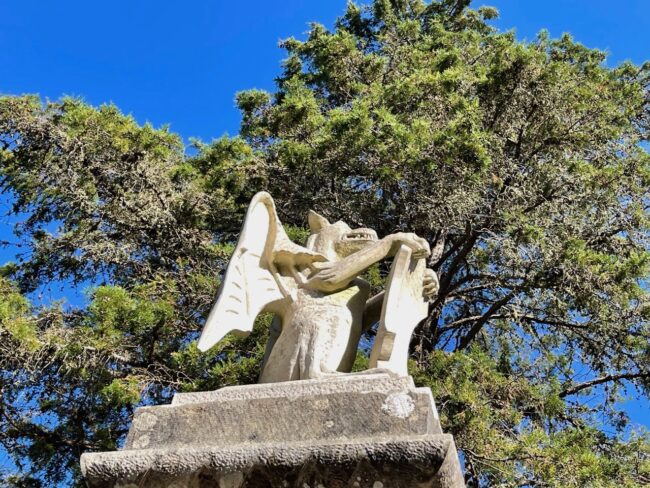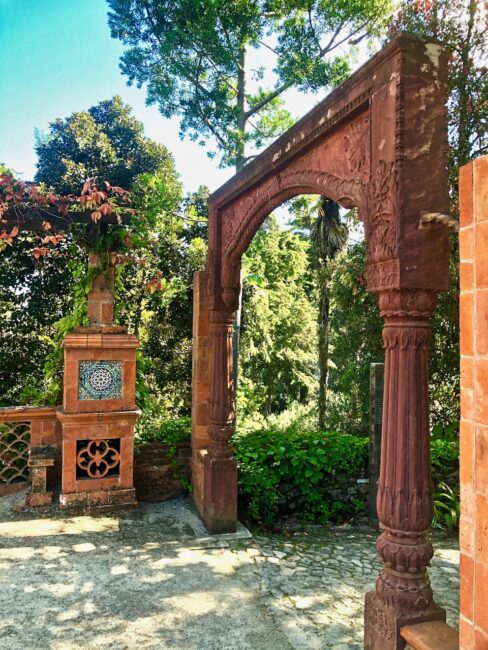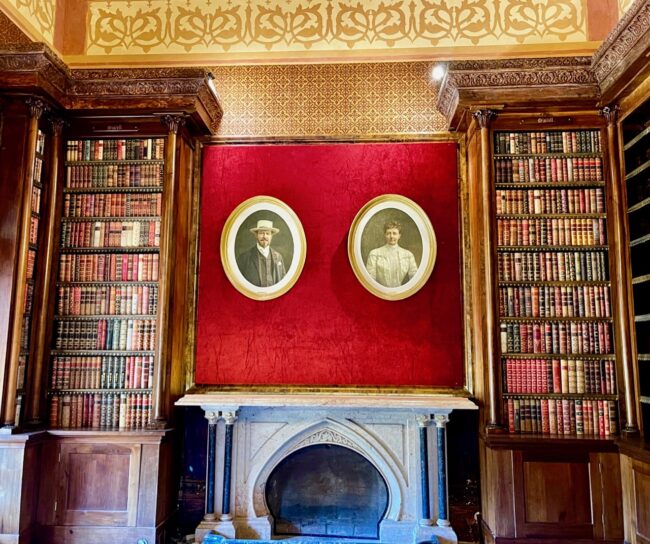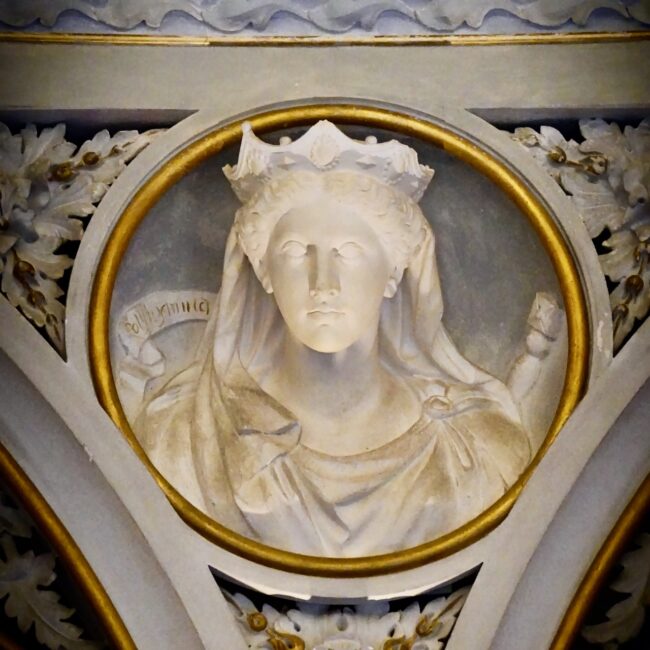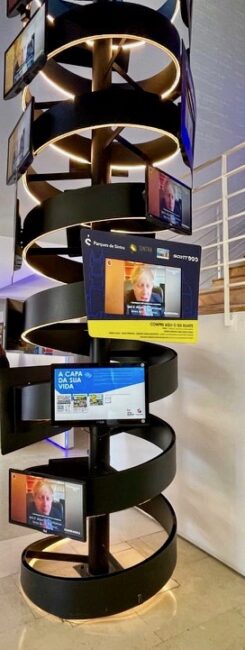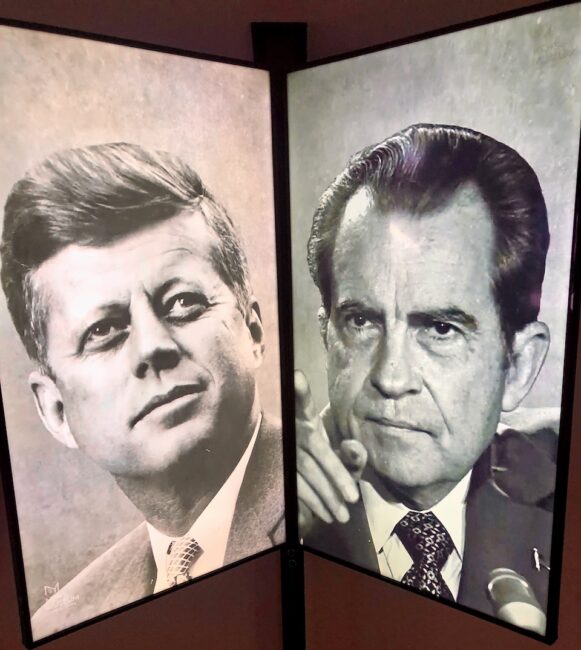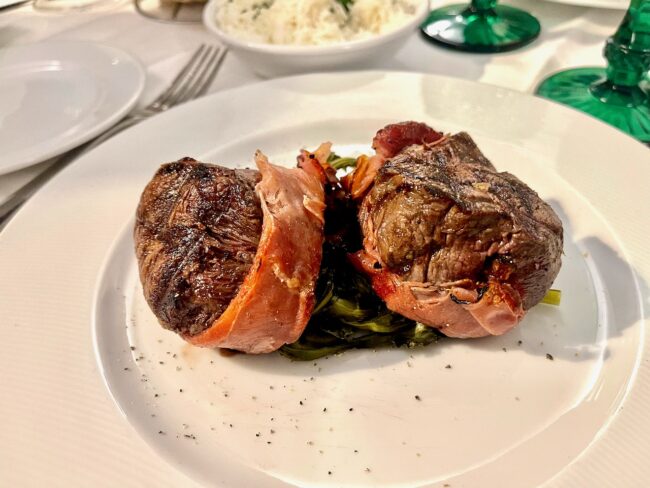
Chapter Eight: Quinta da Regaleira and Palácio da Pena
January 4, 2023
Chapter Ten – Two UNESCO World Heritage Sites On The Way To Tomar
January 19, 2023Falling For Portugal: A Mai Tai Tom “Trip” Report
Chapter Nine: Magical, Mystical Monserrate
Day Nine: The Early Birds, A Lovely Walk, Stunning Palace, Less Is Moor, The First Lawn Planted In Portugal, Here Is The News, Somebody Call An Ambulance, What Color Is Diesel?, Toll Unit and the “Real” Deal
On a windy, sunny day and we we were up early for a quick breakfast at Café Saudade before hitting our final Sintra palace.
We hailed an Uber for the 15 minute ride to the Parque & Palácio de Monserrate, another magical and mystical spot on our Sintra bingo card. The palace (villa) was commissioned by Sir Francis Cook, an English textile millionaire, in 1853 and inspired by Islamic architecture. Cook was also the owner of one of the largest private art collections in Britain.
Back in 1793, however, English novelist William Thomas Beckford subleased the property and designed a landscaped garden. He did such a good job that when Lord Byron visited in 1809 he was captivated by its beauty. He called it the “first and most beautiful place on this land.” Arriving just a few minutes after it opened, after being greeted by a statue of a gargoyle (I think), we started through a portion of the park including the Indigenous Forest. We came upon a sign indicating various paths to the palace. Since little was in bloom, we decided to explore the Vale dos Fetos (Fern Valley).
The Valley supposedly has a unique microclimate lending itself to a “tremendous collection of Tree ferns.”
I’m not sure if this the edge of Hippocreme, a lake named after either a legendary fountain in ancient Greece or a sunscreen for hippopotami.
The gardens at Monserrate are one of the earliest Romantic gardens ever planted and in other seasons would be abloom with rhododendrons, azaelas, hydrangeas, camellias and roses. As a matter of fact, Cook sourced exotic species from all over the world when he expanded the gardens.
It was another stunningly beautiful blue sky day to take a stroll in another park. Besides the park in Monserrate, we were told that not only does the entire Parques de Sintra that surrounds the palaces have an abundant number of flowers, plants and trees, but if you also add in all the species of animals and birds, the total comes out close to 3,000 different varieties when you add them all together.
Near the palace is the Indian Arch, which was acquired by Cook after the Sepoy Mutiny of 1857, where Indians protested against “the campaign of westernization by the East India Company. The British army, after defeating the mutineers, sacked and destroyed many Indian palaces.”
The path headed straight up from the arch to the palace, considered to be a “masterpiece of Romanticism.” It was designed by architect James Knowles Jr. with a lot of input from Cook. It has been completely restored.
The palace and park became a popular retreat for writers, especially from Britain. The Triton Fountain stands out front.
The garden entrance was where family and friends hung out, and where they could easily access many of the rooms. Today, there is very little furniture in the palace, so you can spend your time admiring the incredible architectural features as you walk through.
Since our 2015 trip to Spain, I’ve been intrigued by Moorish architecture, so I was really looking forward to our visit. We would not be disappointed. Walking into the Main Hall, once again a ceiling claimed our attention and Tracy’s camera. The Octagon dates all the way back to the original palace when it was inhabited by William Beckman. It was inspired by the Founder’s Chapel of Mosteiro da Batalha, which we would visit in a few days. Quite remarkable.
The Sacred Art Room contained religious artifacts and some of those ever-present stained glass windows (that might total up to a million by now).
The Moorish influence of The Central Gallery was apparent. It seemingly goes on forever as you walk through the palace. Those people look very small in the long hallway. There is no more photogenic spot in the palace, in my opinion.
The Billiards Room isn’t like other Billiard Rooms I have seen, plus somebody “lost” the pool table sometime in the last century, which presumably put him or her behind the eight ball.
Once again, Tracy falls in love with a ceiling.
The library was restored a little more than a decade ago and is, according to our notes, the only room that has a door. I guess I’ll have to return to see if that is true.
Going upstairs, looking back down at the Main Atrium with its fountain is a tad vertiginous.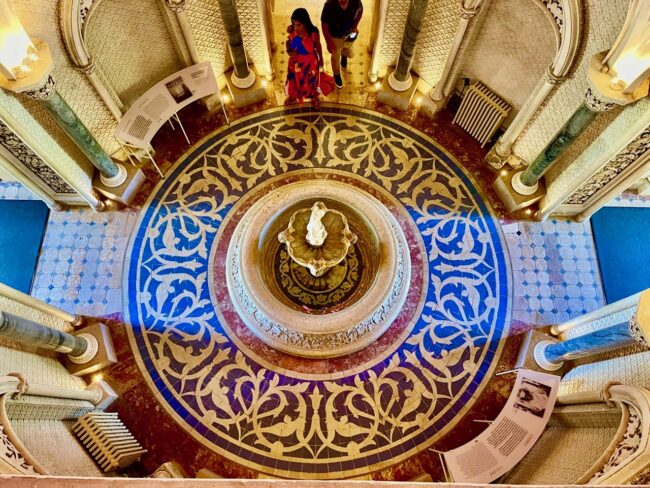
Like Judy Collins, Mary contemplated the palace layout from both sides now.
We looked out at the “first lawn ever planted in Portugal.” Its vast expanse would have made it difficult for Clint Eastwood to yell at people to get off it.
Back downstairs, or I think we were downstairs, is the Dining Room. The statue makes it seem more like a chapel. I read that canopies were utilized in this room to make a sort of “Oriental tent” for diners.
The other room that is stunning throughout is this room. The Music Room is considered the main hall of the palace, although there is a room called the Main Hall. But I digress. It is a spectacularly beautiful room where concerts were held, so its design was to make this room acoustically perfect.
Once again, the cupola is the highlight of the room, with its white and gold motifs.
Tracy and my biggest highlight was watching Kim and Mary get down on the floor to take ceiling photos (or look for a missing contact lens, I truthfully forget which). But it was the duo getting up off the floor so deftly that was truly spectacular. Tracy, Mary and Kim all took ceiling photos in this room, while I wisely stayed upright or we might have missed lunch trying to peel me off the floor.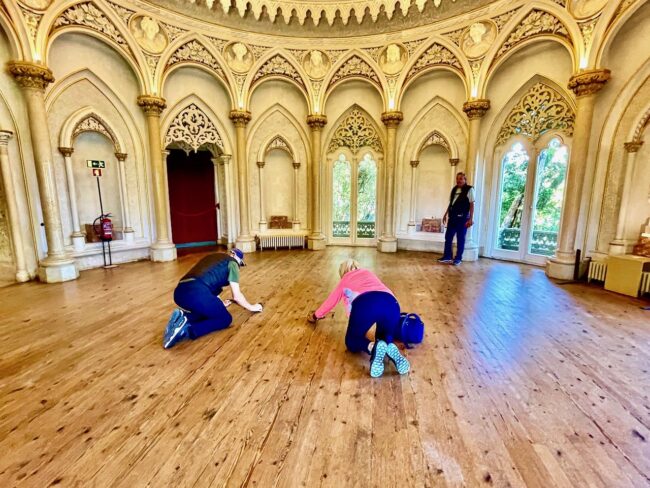
The Central Gallery is a stunner no matter where you stand in it.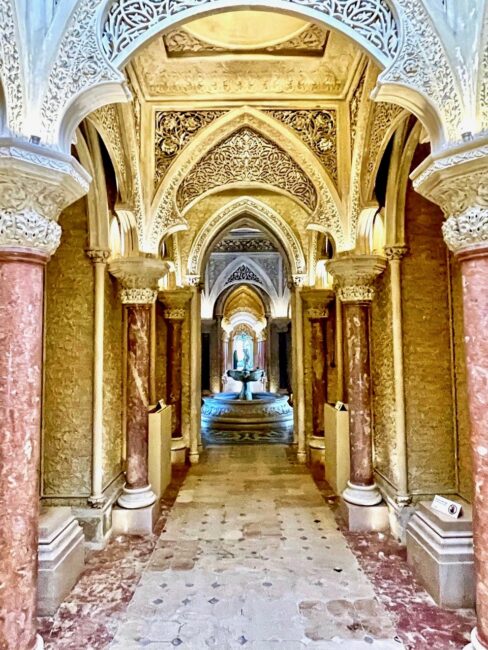
Isn’t this the gargoyle from the entrance on the left?
Palácio de Monserrate and Quinta de Regaleira were our favorites of all the palaces we visited in Sintra, however it seems you can’t go wrong by visiting any one of them.
We walked back along circuitous paths to the entrance, and we would really like to see the park when more flowers and plants are blooming.
Although not on everyone’s radar, I think Monserrate should be at or near the top of your list. The views weren’t bad either.
For the 492nd time on vacation, there was something lost in translation, this time with the Uber driver who picked us up in Monserrate. And, as always, I was the person who instigated the confusion. I had plugged in that we wanted to head back to Sintra when I ordered the Uber, but while waiting, I thought that since it was a beautiful day, we could have him drive us to Cabo San Roca, which is the westernmost point in all of continental Europe. When he arrived, I attempted to tell him we would rather go there and then come back to Sintra. I used my best Portuguese to explain, which also happens to be the worst Portuguese on the planet. After about five minutes I gave up, and back to Sintra we went.
Back in town, I told this guy about the palaces we had seen in the last 48 hours, and he turned green with envy.
In hindsight, I should have planned something better for Sunday afternoon. Knowing, however, that we only had a couple of hours before we had to return to the Lisbon Airport to pick up our rental car, I said, “Let’s go to the News Museum.” I had read good things about it, which said that even foreigners would find it quite interesting. Since we are news junkies, Mary, Kim and I bought our tickets. Meanwhile Tracy meandered through Sintra trying to find news of her own, which she would (stay tuned). Of course, wherever we travel, the paparazzi is certain to be hounding my every move, just as they did when as I walked the red carpet of the News Museum.
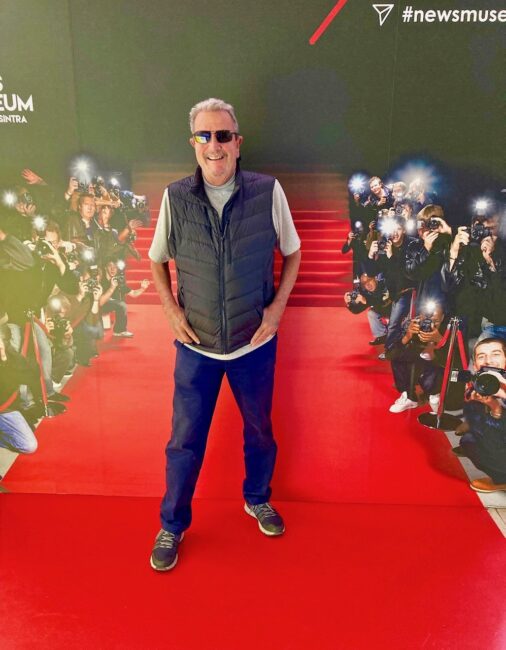 It seems wherever we travel, Boris never very far away.
It seems wherever we travel, Boris never very far away.
Had we looked more in depth and if more of the exhibits had been translated, I’m sure we would have enjoyed this more, but by now after 48 seemingly continuous hours of palace-hopping, none of us were really in the mood. However, there was no debate on who these guys were.
There were interesting tidbits about freedom of the press …
… and also grim reminders that those freedoms can come at a cost.
I enjoyed the trivia game of news events and history (yes, this was a lucky guess), but it was time to pick up our rental car.
First we had to find Tracy, and she came running toward us (which we call “walking fast” at our age) with big news. She had gone to the National Palace to take some exterior photos and video, and just as she got there an ambulance arrived on the scene, picking up yet another person who had taken a tumble on some stairs.
On the way back to the hotel, Tracy saw more houses we should make an offer on. I think this was too big a pink house for even John Mellencamp.
We picked up our rental car at the Lisbon Airport because there are no rental car agencies in Sintra. Plus, it was only a 25-minute Uber ride from our hotel (or about 1/3 the time it takes to get from our house to LAX in traffic). Be certain to get the Toll Transponder Device (below from internet) for the car which alerts you every time there is a toll (stay in Via Verde lane) and will send you a bill at the end rather than stopping each time (our toll bill ended up being a minuscule $14 US for the remainder of the trip). We also diligently took a video of the car checking especially for “road burn” on the wheels, as we have been unfairly charged on a few occasions, like in Great Britain a few months previously (we actually won that dispute).
We arrived back to the hotel just in time for another marvelous meal. Tacho Real ( R. Ferraria 4) located in central Sintra is housed in an old home that doubles as a charming restaurant. It has a lovely interior space with arched ceilings, green tile and, most importantly, sumptuous food.
My creamed pumpkin soup with foam and pesto drizzle was a delight.
I devoured my perfectly cooked steak with Roquefort and shallot sauce. No,I was not counting calories on this trip
Even better was Tracy’s Steak au Poivre.
Every dish was delightful.
After dinner, we walked past the News Museum, which was lit in various colors.
Back at the Chalet Saudade, Tracy and I sipped a glass of port with a few of the guests in the quaintness of its sitting area. Over the course of three nights, we met some very nice people mostly from the U.S. and Canada.
The following day would be a road trip (always dangerous with this group) from Sintra to Tomar via two massive UNESCO World Heritage Sites. The Mosteiro Pálacio Nacional de Mafra actually took 50,000 people to build and has more than 1,200 rooms, including a library that has some very special helpers. After an ill-advised detour, before hitting Tomar, we would also stop at Mosteiro de Santa Maria de Alcobaça, a humongous monastery that dates back nearly 1,000 years. We even got an extra special tour, but not before Mary and our guide eventually got the door open.
 Chapter Ten – UNESCO World Heritage Sites & On To Tomar
Chapter Ten – UNESCO World Heritage Sites & On To Tomar
Day Ten – Two Towers Are Better Than One, Where Did The Royals Go?, Going Batty In The Library, We’re On The Road To Nowhere, Getting A Food Complex, That’s The Ticket, Marvelous Monastery, A “Key” Development, Altarpiece Like No Other and Time For Tomar





